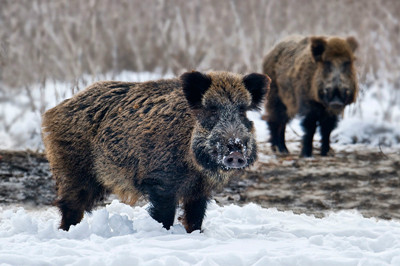(单词翻译:单击)
听力文本
The standard story told about domesticating wild animals goes something like this:humans selected individuals with a desired trait—docility, for example and bred those animals together to produce offspring even more docile than their parents.
Eventually the breeders created a genetic bottleneck that separated domestic animals from their wild relatives.
And they brought their livestock along as they spread across Europe and Asia.
But now a group of scientists has demonstrated that the story is far too tidy—at least when it comes to pigs.
Pigs were domesticated from wild boar at least twice, in Anatolia in present day Turkey and in the Mekong Valley in China, both about 9,000 years ago.
They arrived in Europe about 7,500 years ago.
For this study, researchers focused on European pigs.
They evaluated more than 600 genomes from European and Asian wild boars and domesticated pigs.
And they found that, in Europe, the story of a bottleneck separating domestic from wild animals does not fit the genetic data.
Rather, the model that does fit indicates that there was a frequent flow of genes from wild European boars into the domestic population.
In other words, boars and pigs kept finding ways to get together.
The most likely scenario for the development of the modern pig genome includes gene flow from some species of European wild boars that are now extinct.
But their genes live on, on the farm.
The research is in the journal Nature Genetics.
The authors hope this study will prompt the use of genetics to evaluate the domestication history for other species, including dogs and horses.
They say the incorporation of contemporary and ancient DNA into these modeling scenarios will help elucidate the timing of the domestication of plants and animals and, “ultimately substantially enhance knowledge of this fascinating evolutionary process.”
参考译文
驯化野生动物的标准说法是这样的:人类希望选择具备顺从等特征的个体,然后人类将这些动物在一起进行饲养,希望繁育出比父母一代更为温顺的后代。
最终这些饲养者在将驯化的动物同野生动物区分离这样的遗传问题上遇到了瓶颈。
而后他们横跨欧亚大陆时也带上了这些牲畜。

但是现在一些科学家们已经证明这样的理论不太准确—至少涉及猪的时候是这样。
猪至少经过2次驯化,一次是现在土耳其的安纳托利亚,还有一次是在中国的湄公河流域,而这2次均发生在9000年前。
它们进入欧洲大陆是在大约7500年前。
而在这次研究当中科学家们将焦点集中在欧洲猪身上。
他们对欧洲,亚洲野生猪及家猪的600多个基因组进行了对比分析。
结果他们发现在欧洲,曾提到过的野生动物与家畜遗传基因分离瓶颈的故事同基因数据并不相符。
相反,相符合的模型显示有一股基因流频繁从欧洲野生猪进入到家养猪群当中。
换句话讲,野猪同家猪一直在寻找在共存的方法。
对于现代猪基因组发展最有可能的情况是它们的基因中包括一些已经现在已经灭绝欧洲野生猪身上的基因组。
但它们的基因却活了下来,就在农场里。
这项研究已经在《自然遗传学》杂志上发表。
这项研究的作者表示该研究会促进使用遗传数据来评估包括狗和猫在内其他物种的驯化历史。
他们表示现代和古代DNA整合到这些场景将有助于阐明动植物的驯化时机,最终会揭开令人心驰神往进化过程的神秘面纱。”
译文为可可英语翻译,未经授权请勿转载!
重点讲解
1.separate from 分开
例句:Business bank accounts were kept separate from personal ones.
银行的商业账户和个人账户是分开管理的。
2.at least 至少
例句:What they wanted most from the president was a leader who at least would try to educate the country.
他们对总统最大的期待是,至少他应尽力教诲国民。
3.arrive in 到达
例句:Can we arrive in Beijing on time or not?
我们能否按时到达北京?
4.focus on 集中于
例句:I think to focus on commonly held views that Chinese education isn 't particularly strong in promoting creativity.
通常人们认为中国的教育方式在鼓励创新方面并不强。


